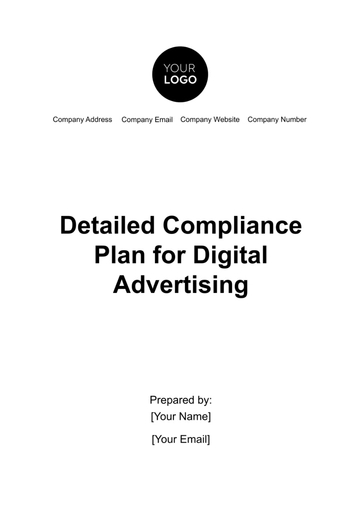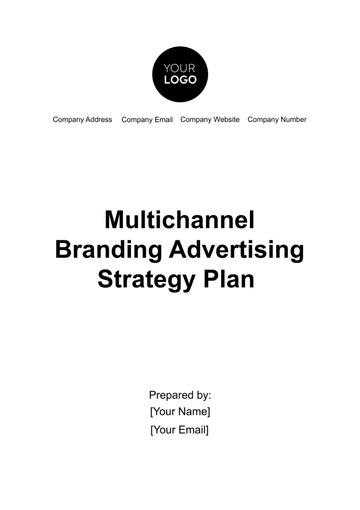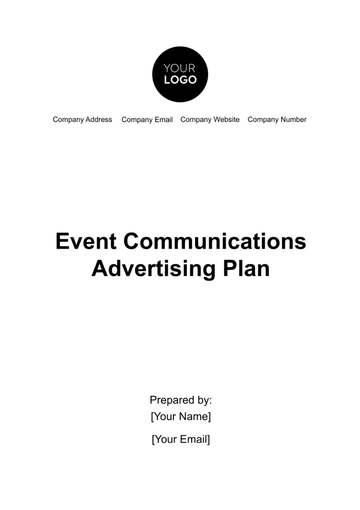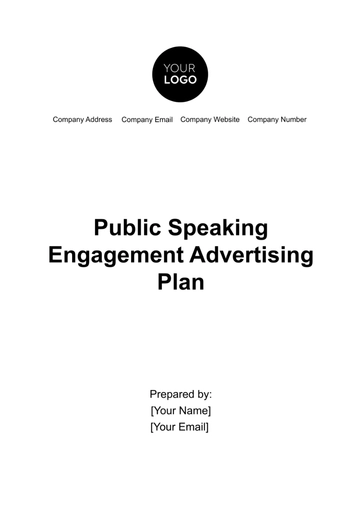Free Advertising Online Reputation Management Plan
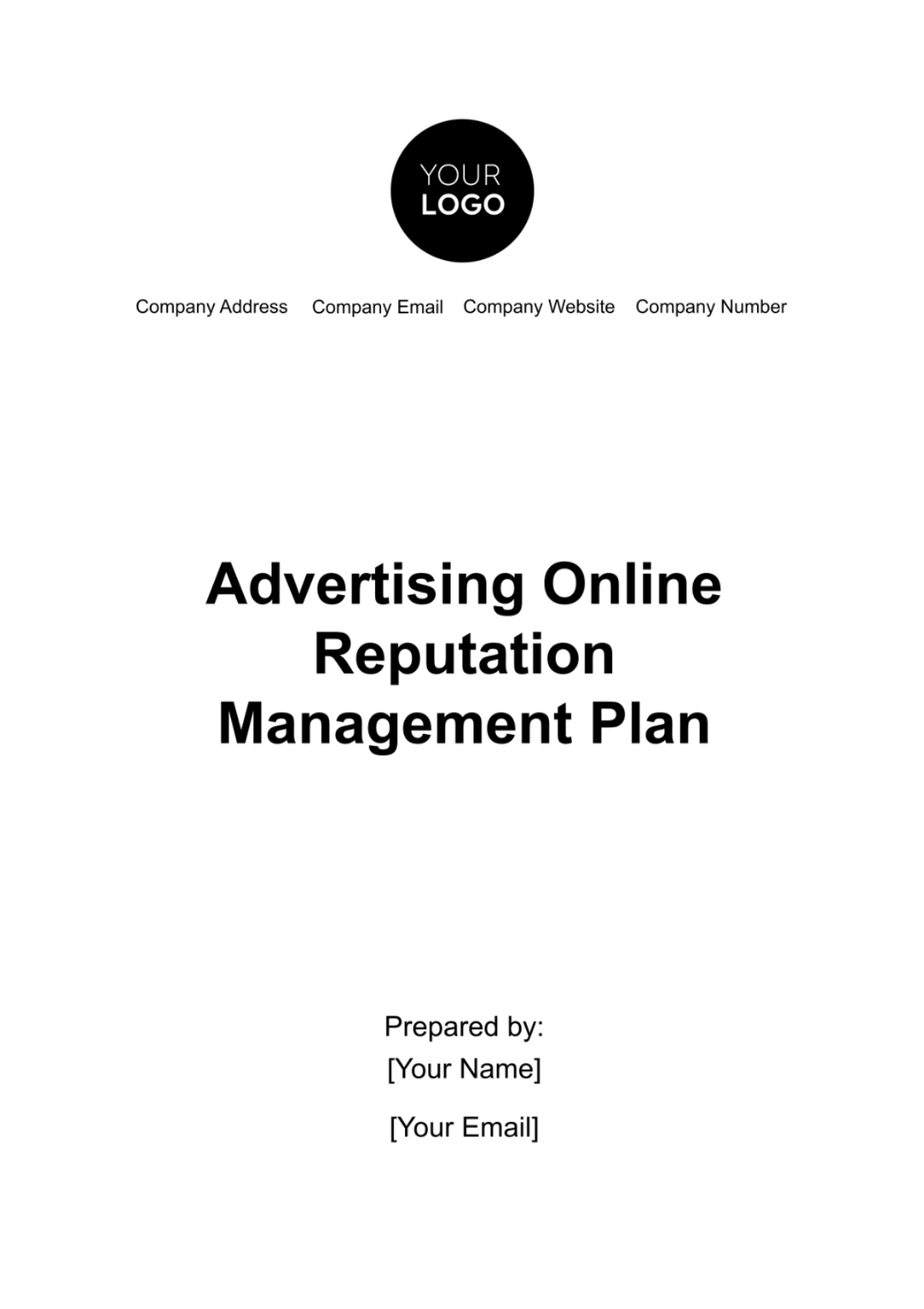
Management Plan
Introduction
This document serves as a strategic guide for managing and enhancing [Your Company]'s online reputation. In the digital age, a company's online presence is pivotal to its success, and proactive reputation management is essential.
The plan aims to cultivate a positive online presence, rapidly address negative perceptions, and build a strong, trustworthy brand image. We strive to ensure that online interactions reflect our company's values and commitment to excellence.
Section 1: Online Reputation Monitoring
A. Monitoring Tools and Techniques
[Your Company] employs advanced tools for continuous monitoring of its online presence.
Tool | Function |
|---|---|
Google Alerts | Tracks mentions across news and blogs |
B. Key Metrics and KPIs
Our team closely monitors several key performance indicators to assess the brand's online health.
Mention Sentiment: Analyzing whether mentions are positive, negative, or neutral.
Frequency of Mentions: Tracking the volume of brand mentions over time.
Response Time: Measuring the speed of our responses to online interactions.
C. Trend Analysis
Regularly analyzing online trends to anticipate potential reputation issues and opportunities for positive engagement.
Section 2: Responding to Feedback
A. Response Protocols
Customized response protocols are in place to address various types of online feedback.
Positive Feedback: Acknowledgment and reinforcement of positive interactions.
Neutral Feedback: Offering additional information to increase engagement.
Negative Feedback: Swift, empathetic, and solution-focused responses.
B. Crisis Communication Plan
A dedicated crisis communication team is tasked with managing significant reputation issues.
Rapid Response Team: A group of trained professionals ready to address crises.
Communication Channels: Utilizing all available channels for effective crisis communication.
C. Employee Advocacy
Encouraging employees to positively represent and defend the company online, within the scope of our social media guidelines.
Section 3: Proactive Reputation Building
A. Content Strategy
Our content strategy focuses on highlighting [Your Company]'s strengths and achievements.
Success Stories: Sharing customer testimonials and case studies.
Corporate Responsibility: Showcasing our community and environmental initiatives.
B. Engagement Initiatives
Regularly engage with our audience through various interactive initiatives.
Online Q&A Sessions: Hosting sessions to address customer queries and concerns.
Community Events: Participating in and sponsoring community events to build goodwill.
Section 4: Influencer and Partnership Collaborations
A. Collaborating with Influencers
Identifying and partnering with influencers who align with our brand values for mutual promotion.
Influencer Selection Process: Careful selection based on audience relevance and credibility.
Content Co-Creation: Working with influencers to create authentic and engaging content.
B. Strategic Partnerships
Forming partnerships with entities that complement and enhance our brand reputation.
Partnership Criteria: Choosing partners based on shared values and audience overlap.
Joint Initiatives: Collaborative projects and campaigns for broader impact.
Section 5: Review and Feedback Management
A. Encouraging Positive Reviews
Implementing strategies to motivate satisfied customers to share their positive experiences.
Review Incentives: Offering incentives for customers to leave reviews.
Customer Spotlight: Featuring positive reviews in our marketing materials.
B. Addressing Negative Reviews
Developing a systematic approach to handle negative reviews constructively.
Resolution Process: A step-by-step approach to address and resolve customer issues.
Follow-up Strategy: Ensuring customer satisfaction post-resolution.
Section 6: Training and Internal Guidelines
A. Employee Training
Regular workshops and training sessions to educate employees about the importance of online reputation.
Training Modules: Covering best practices in online communication and brand representation.
Regular Updates: Keeping staff informed about the latest online reputation management strategies.
A. Social Media Guidelines
Clear guidelines for employees' online conduct, balancing personal expression with brand representation.
Dos and Don'ts: Explicit instructions on acceptable online behaviors.
Brand Advocacy: Encouraging employees to positively promote the company.
Section 7: Legal Considerations
A. Compliance with Laws and Regulations
Ensuring all online activities are compliant with legal standards, including data privacy and advertising laws.
B. Handling Defamatory Content
Strategies for dealing with false or defamatory content about the company.
Legal Protocols: Procedures for addressing legally questionable content.
Crisis Mitigation: Steps to mitigate the impact of defamatory claims.
Section 8: Digital Asset Management
A. Website and Social Media Presence
Maintaining a strong and positive presence on our website and social media platforms is crucial. Regular updates, engaging content, and a user-friendly interface are key.
Website Optimization: Ensuring the website reflects current branding and messaging, is SEO optimized, and user-friendly.
Social Media Updates: Regularly updating our social media profiles with fresh, relevant content.
B. Online Portfolio Management
Our online portfolio, including case studies, product descriptions, and client testimonials, is regularly reviewed and updated to showcase our best work and achievements.
Portfolio Updates: Keeping our online showcase current with our latest projects and innovations.
Client Testimonials: Actively seeking and displaying feedback from satisfied customers.
Section 9: Customer Relationship Management
A. Building Customer Loyalty
Fostering customer loyalty is vital for reputation management. We implement loyalty programs and regular customer engagement strategies to keep our customers connected and satisfied.
Loyalty Programs: Offering rewards and incentives for repeat customers.
Customer Engagement: Regular communication with customers through newsletters, updates, and exclusive offers.
B. Handling Customer Complaints
A dedicated process for handling customer complaints effectively and empathetically is in place to ensure customer satisfaction and mitigate negative online feedback.
Complaint Resolution Protocol: A step-by-step guide for our customer service team to address and resolve complaints.
Feedback Loop: Incorporating customer feedback into service improvements.
Section 10: Continuous Improvement and Adaptation
A. Regular Audits and Adjustments
Regular audits of our online reputation management strategies are conducted to identify areas for improvement and adaptation to changing digital trends.
Strategy Audits: Evaluating the effectiveness of current reputation management strategies.
Adaptation Plans: Making adjustments based on audit findings and emerging online trends.
B. Learning from Industry Best Practices
We continuously monitor and learn from the best practices in the industry, adapting strategies that align with our brand values and objectives.
Industry Benchmarking: Comparing our strategies with industry leaders.
Best Practice Implementation: Incorporating successful strategies from industry peers.
Section 11: Employee Online Advocacy Program
A. Encouraging Positive Employee Engagement Online
Employees are valuable advocates for our brand. We encourage and guide them to positively represent [Your Company] in their personal online interactions.
Advocacy Guidelines: Providing clear guidelines for employees to engage in online advocacy responsibly.
Training Sessions: Regular training on effective and appropriate online advocacy.
B. Tracking Employee Advocacy Impact
Monitoring the impact of employee advocacy on our brand's online reputation is crucial. We track key metrics to assess the effectiveness of this initiative.
Metric | Description |
|---|---|
Engagement Rate | Interaction on employee-shared content |
Section 12: Local Community Engagement
A. Strengthening Local Community Ties
Engaging with local communities helps build a strong, relatable brand presence. We participate in and sponsor local events, charities, and initiatives.
Community Events: Hosting and participating in local community events.
Charitable Initiatives: Supporting local charities and causes.
B. Impact Measurement
Assessing the impact of our community engagement activities on our online reputation is essential.
Community Activity | Impact Measurement Criteria |
|---|---|
Event Participation | Online mentions and sentiment post-event |
Section 13: Leveraging Customer Feedback for Improvement
A. Systematic Collection of Customer Feedback
We systematically collect and analyze customer feedback from various online channels to understand their experiences and expectations.
Feedback Channels: Utilizing surveys, social media, and review platforms to gather feedback.
Analysis and Reporting: Regular analysis of feedback for insights and trends.
B. Utilizing Feedback for Continuous Improvement
Customer feedback is a goldmine for continuous improvement. We use this feedback to refine our products, services, and online interactions.
Feedback Type | Action Taken |
|---|---|
Product Improvement Suggestions | Incorporation into product development cycles |
Conclusion
The [Your Company] Advertising Online Reputation Management Plan is a comprehensive, dynamic guide designed to maintain and enhance our online reputation. It encompasses a range of strategies from digital asset management to customer relationship building, and continuous improvement. This document will be regularly reviewed and updated to ensure it remains effective and relevant in the ever-changing digital landscape.
- 100% Customizable, free editor
- Access 1 Million+ Templates, photo’s & graphics
- Download or share as a template
- Click and replace photos, graphics, text, backgrounds
- Resize, crop, AI write & more
- Access advanced editor
Safeguard your brand's online presence with Template.net's Advertising Online Reputation Management Plan Template. This editable, customizable plan outlines strategies for managing your brand's reputation in the digital space. Crucial for PR and marketing professionals, it helps in proactive reputation management, ensuring positive brand perception and handling online feedback effectively.
You may also like
- Finance Plan
- Construction Plan
- Sales Plan
- Development Plan
- Career Plan
- Budget Plan
- HR Plan
- Education Plan
- Transition Plan
- Work Plan
- Training Plan
- Communication Plan
- Operation Plan
- Health And Safety Plan
- Strategy Plan
- Professional Development Plan
- Advertising Plan
- Risk Management Plan
- Restaurant Plan
- School Plan
- Nursing Home Patient Care Plan
- Nursing Care Plan
- Plan Event
- Startup Plan
- Social Media Plan
- Staffing Plan
- Annual Plan
- Content Plan
- Payment Plan
- Implementation Plan
- Hotel Plan
- Workout Plan
- Accounting Plan
- Campaign Plan
- Essay Plan
- 30 60 90 Day Plan
- Research Plan
- Recruitment Plan
- 90 Day Plan
- Quarterly Plan
- Emergency Plan
- 5 Year Plan
- Gym Plan
- Personal Plan
- IT and Software Plan
- Treatment Plan
- Real Estate Plan
- Law Firm Plan
- Healthcare Plan
- Improvement Plan
- Media Plan
- 5 Year Business Plan
- Learning Plan
- Marketing Campaign Plan
- Travel Agency Plan
- Cleaning Services Plan
- Interior Design Plan
- Performance Plan
- PR Plan
- Birth Plan
- Life Plan
- SEO Plan
- Disaster Recovery Plan
- Continuity Plan
- Launch Plan
- Legal Plan
- Behavior Plan
- Performance Improvement Plan
- Salon Plan
- Security Plan
- Security Management Plan
- Employee Development Plan
- Quality Plan
- Service Improvement Plan
- Growth Plan
- Incident Response Plan
- Basketball Plan
- Emergency Action Plan
- Product Launch Plan
- Spa Plan
- Employee Training Plan
- Data Analysis Plan
- Employee Action Plan
- Territory Plan
- Audit Plan
- Classroom Plan
- Activity Plan
- Parenting Plan
- Care Plan
- Project Execution Plan
- Exercise Plan
- Internship Plan
- Software Development Plan
- Continuous Improvement Plan
- Leave Plan
- 90 Day Sales Plan
- Advertising Agency Plan
- Employee Transition Plan
- Smart Action Plan
- Workplace Safety Plan
- Behavior Change Plan
- Contingency Plan
- Continuity of Operations Plan
- Health Plan
- Quality Control Plan
- Self Plan
- Sports Development Plan
- Change Management Plan
- Ecommerce Plan
- Personal Financial Plan
- Process Improvement Plan
- 30-60-90 Day Sales Plan
- Crisis Management Plan
- Engagement Plan
- Execution Plan
- Pandemic Plan
- Quality Assurance Plan
- Service Continuity Plan
- Agile Project Plan
- Fundraising Plan
- Job Transition Plan
- Asset Maintenance Plan
- Maintenance Plan
- Software Test Plan
- Staff Training and Development Plan
- 3 Year Plan
- Brand Activation Plan
- Release Plan
- Resource Plan
- Risk Mitigation Plan
- Teacher Plan
- 30 60 90 Day Plan for New Manager
- Food Safety Plan
- Food Truck Plan
- Hiring Plan
- Quality Management Plan
- Wellness Plan
- Behavior Intervention Plan
- Bonus Plan
- Investment Plan
- Maternity Leave Plan
- Pandemic Response Plan
- Succession Planning
- Coaching Plan
- Configuration Management Plan
- Remote Work Plan
- Self Care Plan
- Teaching Plan
- 100-Day Plan
- HACCP Plan
- Student Plan
- Sustainability Plan
- 30 60 90 Day Plan for Interview
- Access Plan
- Site Specific Safety Plan






















